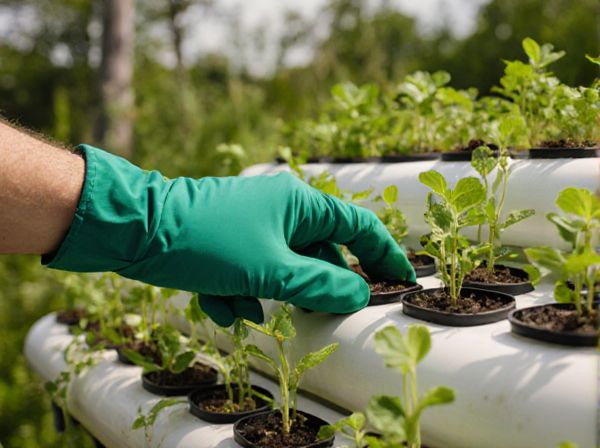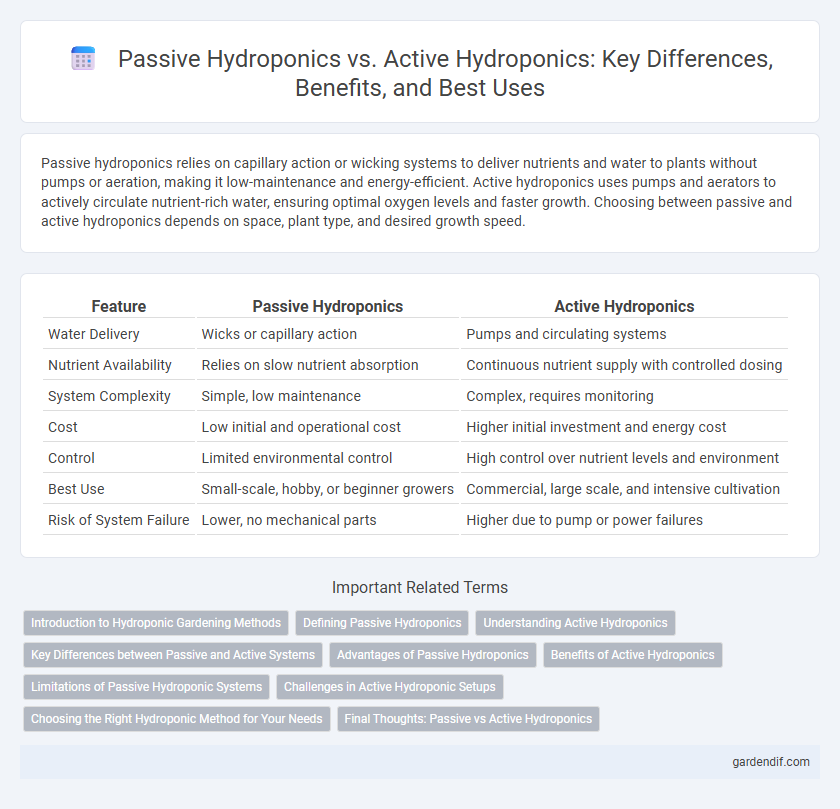
Passive Hydroponics vs Active Hydroponics Illustration
Passive hydroponics relies on capillary action or wicking systems to deliver nutrients and water to plants without pumps or aeration, making it low-maintenance and energy-efficient. Active hydroponics uses pumps and aerators to actively circulate nutrient-rich water, ensuring optimal oxygen levels and faster growth. Choosing between passive and active hydroponics depends on space, plant type, and desired growth speed.
Table of Comparison
| Feature | Passive Hydroponics | Active Hydroponics |
|---|---|---|
| Water Delivery | Wicks or capillary action | Pumps and circulating systems |
| Nutrient Availability | Relies on slow nutrient absorption | Continuous nutrient supply with controlled dosing |
| System Complexity | Simple, low maintenance | Complex, requires monitoring |
| Cost | Low initial and operational cost | Higher initial investment and energy cost |
| Control | Limited environmental control | High control over nutrient levels and environment |
| Best Use | Small-scale, hobby, or beginner growers | Commercial, large scale, and intensive cultivation |
| Risk of System Failure | Lower, no mechanical parts | Higher due to pump or power failures |
Introduction to Hydroponic Gardening Methods
Passive hydroponics relies on a growing medium to wick water and nutrients to plants without electrical components, making it low-maintenance and energy-efficient. Active hydroponics uses pumps or aerators to circulate nutrient solutions, ensuring optimal oxygen and nutrient delivery for faster growth and higher yields. Understanding these methods helps gardeners choose the best system for space, budget, and plant type in hydroponic gardening.
Defining Passive Hydroponics
Passive hydroponics involves growing plants using a growing medium that absorbs and retains nutrient-rich water without the use of pumps or aeration systems, relying primarily on capillary action for water delivery. This method contrasts with active hydroponics, which depends on mechanical systems such as pumps and aerators to circulate and oxygenate the nutrient solution. Passive hydroponics is ideal for low-maintenance setups and is commonly used with inert media like coco coir, perlite, or expanded clay pellets.
Understanding Active Hydroponics
Active hydroponics utilizes pumps and aeration systems to deliver nutrient-rich water directly to plant roots, enhancing oxygen availability and nutrient uptake. This method supports faster growth rates and higher yields compared to passive hydroponics, which relies on capillary action or gravity for nutrient delivery. Precision control of pH, temperature, and nutrient concentration in active hydroponics systems optimizes plant health and maximizes productivity.
Key Differences between Passive and Active Systems
Passive hydroponics relies on capillary action and wicks to deliver nutrients to plant roots, requiring minimal equipment and maintenance, whereas active hydroponics uses pumps and aeration systems to actively circulate nutrient solutions. Passive systems are simpler and more energy-efficient but may limit oxygen availability and nutrient control, while active systems provide better oxygenation, nutrient distribution, and faster growth rates. Key differences include nutrient delivery method, oxygen availability, and system complexity, influencing plant health and yield outcomes.
Advantages of Passive Hydroponics
Passive hydroponics offers significant advantages such as lower energy consumption and reduced system complexity because it relies on capillary action and natural wicking to deliver nutrients, eliminating the need for pumps or timers. This method promotes a more sustainable and cost-effective growing environment, ideal for beginners and small-scale growers. Plants grown with passive hydroponics often experience reduced root stress and improved oxygen availability due to the gentle, consistent water supply.
Benefits of Active Hydroponics
Active hydroponics systems offer precise control over nutrient delivery and oxygenation, which significantly enhances plant growth rates and yields compared to passive methods. By actively circulating nutrient-rich water, these systems prevent stagnation and root diseases, promoting healthier root development. Additionally, active hydroponics allows for scalability and automation, making it ideal for commercial operations seeking higher efficiency and crop consistency.
Limitations of Passive Hydroponic Systems
Passive hydroponic systems, relying on capillary action and wicking to deliver nutrients, face limitations such as inconsistent water and nutrient distribution, which can hinder optimal plant growth. These systems often struggle with oxygen supply to roots since they lack active aeration or circulation, leading to potential root rot or nutrient deficiencies. Limited scalability and reduced control over environmental factors make passive hydroponics less suitable for high-yield or commercial cultivation compared to active hydroponic systems.
Challenges in Active Hydroponic Setups
Active hydroponic setups face challenges such as pump failures, which can disrupt nutrient delivery and oxygenation, leading to stressed plants. Maintaining optimal pH and nutrient concentration requires constant monitoring and adjustments to prevent deficiencies or toxicity. Energy consumption and system complexity also increase operational costs and demand technical expertise for troubleshooting in active hydroponic systems.
Choosing the Right Hydroponic Method for Your Needs
Choosing the right hydroponic method depends on factors such as space, maintenance, and plant type. Passive hydroponics relies on wicking or capillary action to deliver nutrients, requiring less electricity and simpler setup, ideal for beginners or small-scale gardening. Active hydroponics uses pumps and aeration systems to circulate solutions, offering precise control over nutrient delivery and oxygen levels, best suited for larger or commercial operations demanding higher yields.
Final Thoughts: Passive vs Active Hydroponics
Passive hydroponics relies on wicking systems and capillary action to deliver nutrients without mechanical pumps, making it low maintenance and energy-efficient. Active hydroponics uses pumps and aeration to optimize nutrient delivery and oxygenation, resulting in faster plant growth and higher yields. Choosing between passive and active systems depends on factors such as available space, budget, desired crop type, and the grower's experience level.
Passive Hydroponics vs Active Hydroponics Infographic

 gardendif.com
gardendif.com